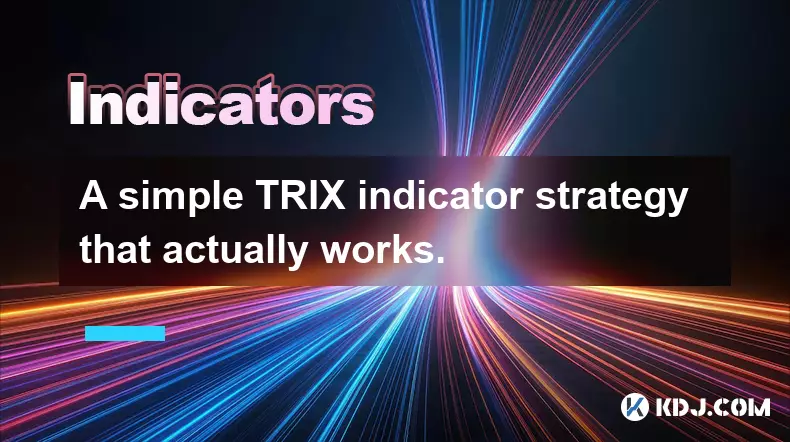-
 bitcoin
bitcoin $102877.190955 USD
1.88% -
 ethereum
ethereum $3430.435064 USD
4.52% -
 tether
tether $0.999264 USD
-0.05% -
 xrp
xrp $2.307310 USD
4.49% -
 bnb
bnb $987.740692 USD
3.82% -
 solana
solana $161.947760 USD
3.97% -
 usd-coin
usd-coin $0.999712 USD
-0.05% -
 tron
tron $0.292810 USD
2.93% -
 dogecoin
dogecoin $0.179738 USD
10.70% -
 cardano
cardano $0.580716 USD
8.75% -
 hyperliquid
hyperliquid $42.463448 USD
8.40% -
 chainlink
chainlink $15.763437 USD
7.05% -
 zcash
zcash $649.595636 USD
17.21% -
 bitcoin-cash
bitcoin-cash $511.610261 USD
7.19% -
 stellar
stellar $0.292537 USD
7.91%
How does the KDJ indicator compare to the Stochastic Oscillator?
The KDJ indicator enhances the Stochastic Oscillator with a J line for sharper momentum signals, making it ideal for spotting reversals in volatile crypto markets like Bitcoin and altcoins.
Nov 06, 2025 at 07:35 am

KDJ Indicator: Structure and Application in Crypto Trading
1. The KDJ indicator is an extension of the Stochastic Oscillator, originally developed in Japan and later refined in China. It introduces a third line—known as the J line—that adds depth to momentum analysis. While both tools measure price momentum relative to recent highs and lows, the KDJ enhances responsiveness by incorporating smoothing algorithms on the K and D values before deriving J. This makes it particularly sensitive to rapid price changes common in cryptocurrency markets.
2. In the context of Bitcoin or altcoin trading, the J line often acts as an early signal generator. When the J value surges above 100 or plunges below 0, it suggests overbought or oversold extremes more aggressively than traditional stochastic readings. Traders monitor these spikes closely, especially when they diverge from price action, as such conditions may precede sharp reversals in volatile digital asset charts.
3. Unlike standard stochastic settings that rely solely on %K and %D crossovers, the KDJ’s triple-line framework allows for layered confirmation. A bullish setup might require %K crossing above %D while the J line pulls back from overextended levels. This multi-filter approach reduces false signals during choppy market phases typical in low-cap token trading.
4. Customization plays a key role in optimizing KDJ parameters for different timeframes. Short-term traders frequently adjust the lookback period to 9 or even 5 candles to capture intraday swings in ETH or SOL. Meanwhile, swing traders may extend the window to 14 or 21 periods to align with broader trend cycles seen in weekly BTC charts.
5. Integration with volume-based indicators improves reliability. For instance, a KDJ-generated buy signal gains strength if accompanied by rising on-chain transaction volume or exchange inflows. This confluence helps distinguish genuine breakouts from noise-driven fluctuations prevalent in meme coin sectors.
Stochastic Oscillator: Core Mechanics and Market Relevance
1. The Stochastic Oscillator operates on the premise that closing prices tend to gravitate toward recent high-low ranges during strong trends. By comparing current close levels to a defined price range, it quantifies momentum shifts. In fast-moving crypto environments, this principle remains valid despite high volatility, offering timely alerts about potential exhaustion points.
2. Two primary variants exist: Fast Stochastic and Slow Stochastic. The Fast version uses raw %K and immediate %D (a moving average of %K), making it highly reactive. However, in erratic markets like those for Dogecoin or Shiba Inu, this sensitivity can produce whipsaws. The Slow Stochastic applies additional smoothing to %K before calculating %D, filtering out minor price noise.
3. Divergence detection is one of its strongest applications. When Bitcoin records a higher high but the Stochastic fails to surpass its prior peak, bearish divergence emerges. Such patterns have historically preceded major corrections, including those during ETF speculation peaks or macroeconomic shocks affecting risk assets.
4. Threshold levels at 20 and 80 serve as baseline references for oversold and overbought zones. Yet, in strongly trending crypto markets, prices can remain outside these bounds for extended durations. Relying solely on threshold breaches without trend context increases the risk of premature entries, especially during bull runs fueled by institutional adoption narratives.
5. Pairing the Stochastic with moving averages or Bollinger Bands creates a more robust decision framework. A crossover signal near the lower band in a sideways ADA chart, for example, carries greater weight than an isolated reading. These combinations help contextualize oscillator outputs within structural price dynamics.
Key Differences Impacting Trading Decisions
1. The inclusion of the J line in KDJ provides an additional layer of insight not present in the classic Stochastic setup. This line amplifies momentum extremes, enabling earlier detection of potential turning points in aggressive markets like leveraged futures trading.
2. KDJ tends to generate more frequent signals due to its heightened sensitivity, which benefits scalpers operating on minute-level charts but demands stricter stop-loss enforcement to manage increased false positives.
3. Stochastic Oscillator's simpler structure favors clarity, especially for beginners analyzing long-term BTC/USD daily charts where excessive signal generation could lead to overtrading.
4. Smoothing techniques differ between the two; KDJ typically applies a weighted calculation involving three-period averages, whereas Slow Stochastic relies on simple moving averages. This distinction affects how each responds to sudden news events, such as regulatory announcements impacting entire blockchain ecosystems.
5. Backtesting results across various cryptocurrencies show KDJ outperforms in mean-reverting scenarios, such as post-halving consolidations, while Stochastic performs better in sustained directional moves driven by halving euphoria or macro liquidity expansions.
Frequently Asked Questions
What timeframes are most suitable for applying KDJ in cryptocurrency trading?The KDJ indicator works effectively on 1-hour, 4-hour, and daily charts. Shorter intervals like 15-minute frames yield too many signals due to extreme volatility, increasing the likelihood of false triggers. On the other hand, weekly data may lag too much for active traders seeking timely entries in fast-paced markets.
Can the Stochastic Oscillator be used during strong trending phases in Bitcoin?Yes, but with caution. During powerful uptrends or downtrends, the oscillator may stay in overbought or oversold territory for prolonged periods. Using it alone can result in missed opportunities or early exits. Combining it with trend-following tools like MACD or Ichimoku Cloud improves accuracy.
How do traders adjust KDJ settings for different altcoins?Highly volatile tokens like PEPE or FLOKI often require shorter lookback periods (e.g., 5–7) to keep pace with rapid price swings. More established coins like XRP or LTC respond better to standard 14-period configurations. Adjustments should be validated through historical testing on specific coin pairs.
Is the J line always reliable for predicting reversals?Not universally. While the J line highlights extreme momentum, it can remain overextended during parabolic moves, such as those seen in AI-themed tokens during hype cycles. Confirmation from candlestick patterns or order book depth strengthens its predictive value.
Disclaimer:info@kdj.com
The information provided is not trading advice. kdj.com does not assume any responsibility for any investments made based on the information provided in this article. Cryptocurrencies are highly volatile and it is highly recommended that you invest with caution after thorough research!
If you believe that the content used on this website infringes your copyright, please contact us immediately (info@kdj.com) and we will delete it promptly.
- Ripple (XRP) in 2026: Hold or Fold? A Look at XRP's Future and Emerging DeFi Alternatives
- 2025-11-08 18:35:01
- Zcash ZEC Coin Price Explosion: From Privacy Niche to Center Stage
- 2025-11-08 18:55:01
- Berachain Price Prediction: Navigating the Honeycomb Hype in Crypto
- 2025-11-08 18:55:01
- Arthur Hayes, Gold, and Bitcoin: A Modern Monetary Trinity?
- 2025-11-08 19:15:01
- Shiba Inu's Next Move: Navigating a Shifting Market
- 2025-11-08 19:20:01
- Pakistan's Crypto Crossroads: Balancing Opportunity with Asset-Backed Realities
- 2025-11-08 19:20:01
Related knowledge

How do professional traders use the TRIX indicator?
Nov 06,2025 at 04:40pm
Understanding the TRIX Indicator in Crypto TradingThe TRIX (Triple Exponential Average) indicator is a momentum oscillator used by professional trader...

Can I use the TRIX indicator on my mobile trading app?
Nov 07,2025 at 07:40pm
The TRIX indicator, a momentum oscillator designed to filter out short-term fluctuations and highlight long-term trends, has become increasingly popul...

How to code a simple TRIX indicator script in Pine Script?
Nov 07,2025 at 06:20am
How to Code a Simple TRIX Indicator in Pine Script The TRIX (Triple Exponential Moving Average) indicator is widely used in cryptocurrency trading to ...

A simple TRIX indicator strategy that actually works.
Nov 08,2025 at 05:39pm
Understanding the TRIX Indicator in Crypto Trading1. The TRIX (Triple Exponential Average) indicator is a momentum oscillator designed to filter out s...

How to trade TRIX indicator signals on the 1-hour chart?
Nov 07,2025 at 05:39am
Bitcoin's Role in Decentralized Finance1. Bitcoin remains the cornerstone of decentralized finance, serving as a benchmark for value and security acro...

Can the TRIX indicator be used for long-term investing?
Nov 06,2025 at 02:19pm
Understanding the TRIX Indicator in Cryptocurrency Markets1. The TRIX (Triple Exponential Average) indicator is a momentum oscillator designed to filt...

How do professional traders use the TRIX indicator?
Nov 06,2025 at 04:40pm
Understanding the TRIX Indicator in Crypto TradingThe TRIX (Triple Exponential Average) indicator is a momentum oscillator used by professional trader...

Can I use the TRIX indicator on my mobile trading app?
Nov 07,2025 at 07:40pm
The TRIX indicator, a momentum oscillator designed to filter out short-term fluctuations and highlight long-term trends, has become increasingly popul...

How to code a simple TRIX indicator script in Pine Script?
Nov 07,2025 at 06:20am
How to Code a Simple TRIX Indicator in Pine Script The TRIX (Triple Exponential Moving Average) indicator is widely used in cryptocurrency trading to ...

A simple TRIX indicator strategy that actually works.
Nov 08,2025 at 05:39pm
Understanding the TRIX Indicator in Crypto Trading1. The TRIX (Triple Exponential Average) indicator is a momentum oscillator designed to filter out s...

How to trade TRIX indicator signals on the 1-hour chart?
Nov 07,2025 at 05:39am
Bitcoin's Role in Decentralized Finance1. Bitcoin remains the cornerstone of decentralized finance, serving as a benchmark for value and security acro...

Can the TRIX indicator be used for long-term investing?
Nov 06,2025 at 02:19pm
Understanding the TRIX Indicator in Cryptocurrency Markets1. The TRIX (Triple Exponential Average) indicator is a momentum oscillator designed to filt...
See all articles





















![The Graph Price Prediction [GRT Crypto Price News Today] The Graph Price Prediction [GRT Crypto Price News Today]](/uploads/2025/11/07/cryptocurrencies-news/videos/690d4df44fe69_image_500_375.webp)



















































